Explore the Legation Quarter
The Legation Quarter has a unique appearance born from a unique history. This is the oldest diplomatic quarter in the city. Following China’s defeat in the Second Opium War (1856-1860), foreign military powers demanded and received the right to build their embassies here. The Boxer Rebellion of 1900 resulted in the near-total destruction of the neighborhood and its later reconstruction as a walled and fortified city-within-a-city. The colonial-style architecture visible today dates from this era, though it is now mostly occupied by Beijing government offices. Text adapted from Beijing by Foot
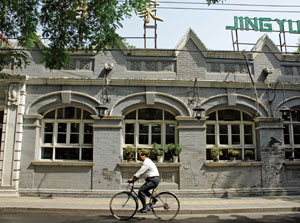 11.30am
11.30am
Start your tour through the Legation Quarter from Chongwenmen Dajie. Walk west towards Dahua Lu and then onto a little alley called Taijichang Toutiao, once known as Rue Hart after a British Customs official named Robert Hart. If you look closely you can still see the old street sign under a coat of paint.
Further south along Taijichang Dajie is St. Michael’s Cathedral built in 1902 as part of the French Legation, one of the few historic buildings still open to the public. The French Legation itself was home for several years to the exiled King Sihanouk of Cambodia.
12.30pm
Head west along Dongjiaomin Xiang to the old French post office turned Sichuan restaurant, perfect for a mid-meander lunch.
1.30pm
After lunch, stroll along Zhengyi Lu and take in the impressive structure that is Yokohama Specie Bank, as well as the former Japanese and British Legations. Zhengyi Lu itself has undergone quite a change – this tree-lined boulevard was once the Yuhe Canal, which originated in Houhai but by this point was mostly a sewage outflow canal for the Forbidden City.
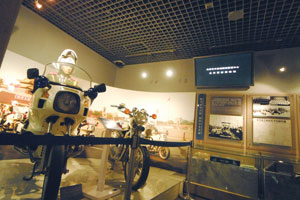 2pm
2pm
Head back to Dongjiaomin Xiang and continue westwards and you’ll come across the National City Bank of New York, now the Beijing Police Museum (see Directory). Kids will love this portion of the tour. Start at the fourth floor, where you get to shoot laser pistols at moving targets, and work your way down through a collection of over 8,000 police tools and weapons from the Han Dynasty to the present. The exhibit on fingerprint forensics is a highlight, as is the gruesome second-floor display of old-fashioned torture devices and photos (families with little kids would be advised to skip it). On the first floor there’s an exhibit detailing the police force’s origins and history – don’t miss the section on Kuomintang reactionary agents and the signed, fingerprinted confessions from failed “subversion schemes.”
3.30pm
The modern jewel in the Legation Quarter’s crown is Ch’ien Men 23. It was once the American Legation but has recently been transformed into a high-class dining and entertainment complex. Well worth a look as well as a post-walk beverage.
 5pm
5pm
If ayi can take the kids off your hands for the evening, we recommend you stay for an intimate dinner for two on the rooftop terrace at The Meat & Wine Co. , or sample fine Italian cuisine at Ristorante Sadler run by two-star Michelin chef, Claudio Sadler.
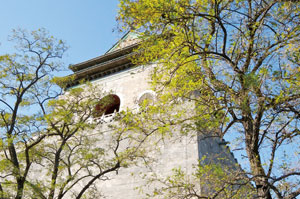 Drum and Bell Towers and Beyond!
Drum and Bell Towers and Beyond!
Although the current structure dates to 1800, buildings similar to the Drum Tower have stood in this vicinity for over 700 years. Today, the tower houses 25 drums that are beaten for visitors every half-hour between 9-11.30am and 2-5pm. Just north of the Drum Tower is the Bell Tower (not to be confused with the Big Bell Temple). A copy of a Yuan dynasty predecessor, the current structure is a sprightly 300 years old. The bell that gives the tower its name is a 500-year-old bronze beast weighing 63 tons. On clear days, the Drum and Bell towers offer splendid views of the leafy neighboring hutongs and the modern concrete jungle in the distance. In the evening, after the pedicab operators and tour buses have left, the plaza between the towers has a neighborhood flavor from days past. From here it’s a mere 15 minute stroll down Gulou Dajie to the trendy Nanluogu Xiang hutong. Make sure you reserve a whole day for this family outing because you won’t want to miss a thing.
Drum and Bell Towers. Daily 9am-5pm. Drum Tower RMB 20, students RMB 10. Bell Tower RMB 15, students RMB 7. Di’anmen Dajie, Dongcheng District. (6401 2674) 钟鼓楼,东城区地安门大街
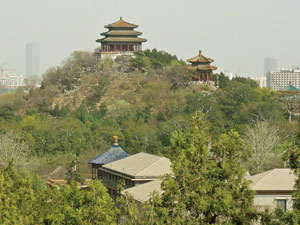 Coal Hill
Coal Hill
Created in 1420 using earth from a moat and the expansion of Beihai’s lakes, this hill is, in fact, far from a Ming dynasty dumping ground. Feng shui principles demanded a sheltering hill to protect the Imperial palace from chilling northern winds. This hill is known by two names in Chinese: “Coal Hill” (Meishan), as coal was often piled at its foot, and “Prospect Hill” (Jingshan), its Qing-era name. A climb to the top is rewarded with beautiful views of the Forbidden City, Tiananmen Square, the National Centre for the Performing Arts (the “Egg”) and Beijing’s ancient symmetry. Go early in the morning for the finest panoramic views of the world’s largest palace complex.
6am-9pm (spring and summer). RMB 2. 1 Wenjin Jie, Xicheng District. (6404 4071) 景山公园,西城区文津街1号
Mei Lanfang’s former residence
The most accomplished Peking Opera star of modern times, Mei Lanfang (1894-1961) became a household name in China for his mastery of female roles, a smooth, poised performance style (now known as the “Mei Lanfang School”) and his comprehensive blending of acting, singing and dancing. During his 50-year career, he played over 100 different roles and served as a cultural ambassador, spreading Peking Opera throughout the world on trips to the USA, Japan and the former Soviet Union. The story of his life was the basis for the 1993 film, Farewell My Concubine, by acclaimed director Chen Kaige, who tackles the subject matter again in the 2008 version Mei Lanfang (English title: Fovever Enthralled). A full Mei Lanfang pilgrimage should include a walk through the surrounding hutongs to Mei Mansion, the elegant restaurant near Houhai that specializes in the opera star’s favorite dishes.
Mei Lanfang’s former residence. Tue-Sun 9am-4pm. RMB 10. 9 Huguosi Lu, Xicheng District. (8322 3598) www.meilanfang.com.cn 梅兰芳纪念馆,西城区护国寺路9号
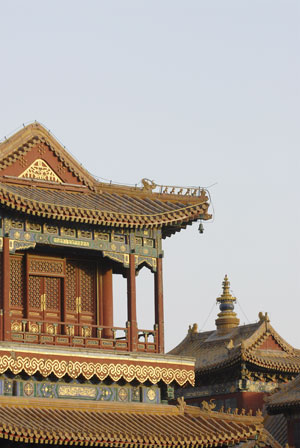 Lama Temple
Lama Temple
The temple is invariably filled with monks, worshippers and tourists. The incense burners are authentic cultural treasures – the one in the second courtyard dates to 1746. Not to be missed is the 18 meter-high Buddha in the last building, which was made from a single piece of sandalwood given by the Dalai Lama to Emperor Qianlong in 1750. It took three years to transport from Nepal to Beijing, and they had to build the hall around the finished statue. If Maitreya looks shorter than 18 meters, it’s because part of the statue is underground, lest it topple over. Beijing’s subway system rattles by right underneath the temple.
Daily 9am-4.30pm. RMB 25, audio tour RMB 20 plus RMB 200 deposit. 12 Yonghegong Dajie, Dongcheng District. (6404 4499 ext 251) 雍和宫,东城区雍和宫大街12号
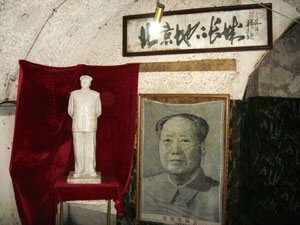 Underground City
Underground City
To the surprise of many tourists, Beijing is mostly hollow underneath. A combined force of the army, citizen “volunteers” and schoolchildren manually dug most of the 85sqkm of tunnels on the orders of Chairman Mao after disputes with “big brother” USSR turned towards the nuclear. The extensive network was designed to hold 40 percent of Beijing’s population; it contains arsenals, infirmaries, schools, theaters, a roller skating rink, a barber shop and even a mushroom cultivation farm. A guide, appropriately wearing camo, leads you through the tunnels, piquing your curiosity by pointing out passages that lead deeper and farther in all directions.
Daily 8.30am-6pm. RMB 20, students RMB 10. 62 Xidamochang Hutong, Qianmen, Chongwen District. (6702 2657) 前门地下城. 崇文区前门西打磨厂胡同62号



